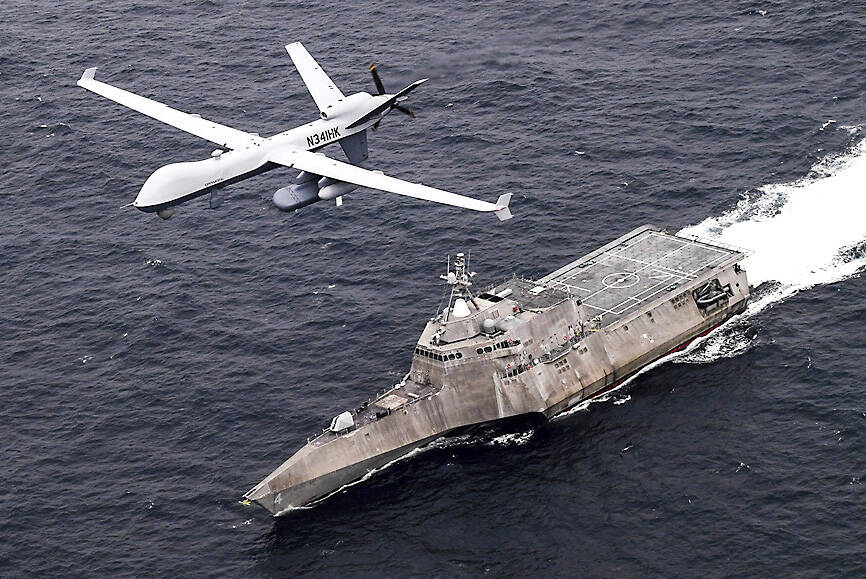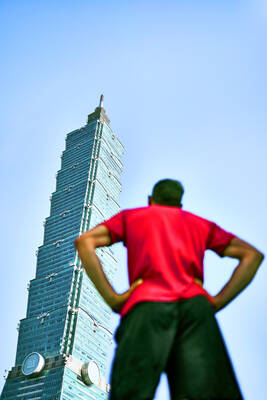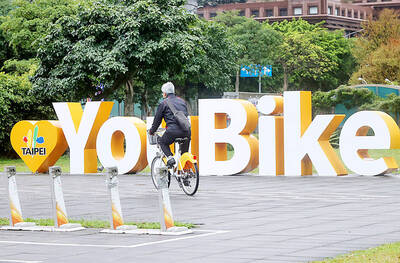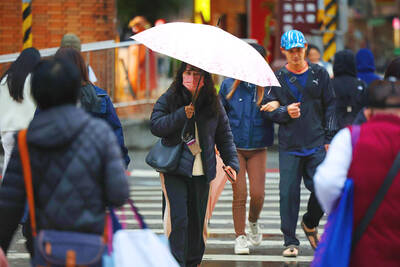Taiwan must revamp its defensive strategy to protect critical infrastructure from uncrewed aerial vehicles (UAV), a Marine Corps officer wrote in the Institute for National Defense and Security Research newsletter.
Drones have played a significantly larger role in the Russia-Ukraine conflict than previously expected, with both sides waging a campaign of drone strikes against their adversary’s infrastructure, Lieutenant Colonel Chang Tzu-hung (張子鴻), a visiting military fellow at the institute, wrote on Aug. 8.
The conflict has underscored that UAVs possess many benefits as weapons systems, including their range, maneuverability and ability to strike from varying altitudes, Chang said, adding that the importance of anti-drone warfare has increased accordingly.

Photo: US Navy / Chief Mass Communication Specialist Shannon Renfroe via AP
Crucial infrastructure protection refers to defensive measures taken to preserve the parts of a country’s infrastructure that are most essential to the maintenance of a functioning government, the armed forces, the national economy and morale, he said.
While the Taiwanese military was apparently successful in defending key infrastructure against simulated air raids and other forms of attacks in this year’s Han Kuang military exercises, techniques still need to be refined to handle the use of UAVs in gray zone activities, he said.
South Korea, vaunted as the world’s sixth most powerful military, proved incapable of dealing with North Korean drones during a large scale incursion that took place in December last year, Chang said.
Drones from the North flew in and around South Korea’s airspace, disrupted more than 30 flights at the Incheon and Gimpo international airports and caused considerable public alarm, he said.
South Korea’s failure to respond to the drones effectively in large part stemmed from a reluctance to employ soft or hard-kill weapons against the UAVs because of the fear that downed drones could result in collateral damage in residential areas, Chang said.
This proves that defending units must have the confidence to take decisive action without delay, and be given clear guidelines with which to assess the risks associated with the loss of civilian lives and property, escalation and the threat the drone might pose to the facility being defended, he said.
The dangers of inaction have to be balanced against the dangers of action such as harming civilians or escalating the situation, Chang added.
Alarmingly, most of Taiwan’s critical infrastructure is in or near urban centers, and the authority to make security arrangements for many strategically valuable facilities falls on civilian agencies without the necessary expertise to create such guidelines, he said.
In addition, drone attacks do not need to destroy a target to achieve an effect in war, as disrupting the normal operations of a key facility is enough to undermine the adversary’s ability to conduct military operations and sustain civilian morale, he said.
In light of these factors, the armed forces’ counter-drone measures cannot be said to be reliably effective, particularly with regard to fending off attacks by small or medium-sized UAVs, Chang said.
The military is urged to explore the specific methods used for identification and tracking, threat reporting, and warning and defense fire with an eye toward shortening the kill chain, he said, referring to the response time between detecting and destroying a threat.
Integrating an algorithmic technology that can automatically identify enemy drones from the input of radar, infrared and optical sensors would be a potential solution to dealing with the UAV threat, Chang said.

US climber Alex Honnold is to attempt to scale Taipei 101 without a rope and harness in a live Netflix special on Jan. 24, the streaming platform announced on Wednesday. Accounting for the time difference, the two-hour broadcast of Honnold’s climb, called Skyscraper Live, is to air on Jan. 23 in the US, Netflix said in a statement. Honnold, 40, was the first person ever to free solo climb the 900m El Capitan rock formation in Yosemite National Park — a feat that was recorded and later made into the 2018 documentary film Free Solo. Netflix previewed Skyscraper Live in October, after videos

Starting on Jan. 1, YouBike riders must have insurance to use the service, and a six-month trial of NT$5 coupons under certain conditions would be implemented to balance bike shortages, a joint statement from transportation departments across Taipei, New Taipei City and Taoyuan announced yesterday. The rental bike system operator said that coupons would be offered to riders to rent bikes from full stations, for riders who take out an electric-assisted bike from a full station, and for riders who return a bike to an empty station. All riders with YouBike accounts are automatically eligible for the program, and each membership account

A classified Pentagon-produced, multiyear assessment — the Overmatch brief — highlighted unreported Chinese capabilities to destroy US military assets and identified US supply chain choke points, painting a disturbing picture of waning US military might, a New York Times editorial published on Monday said. US Secretary of Defense Pete Hegseth’s comments in November last year that “we lose every time” in Pentagon-conducted war games pitting the US against China further highlighted the uncertainty about the US’ capability to intervene in the event of a Chinese invasion of Taiwan. “It shows the Pentagon’s overreliance on expensive, vulnerable weapons as adversaries field cheap, technologically

Temperatures are forecast to drop steadily as a continental cold air mass moves across Taiwan, with some areas also likely to see heavy rainfall, the Central Weather Administration (CWA) said. From today through early tomorrow, a cold air mass would keep temperatures low across central and northern Taiwan, and the eastern half of Taiwan proper, with isolated brief showers forecast along Keelung’s north coast, Taipei and New Taipei City’s mountainous areas and eastern Taiwan, it said. Lows of 11°C to 15°C are forecast in central and northern Taiwan, Yilan County, and the outlying Kinmen and Lienchiang (Matsu) counties, and 14°C to 17°C